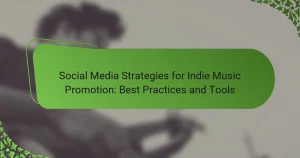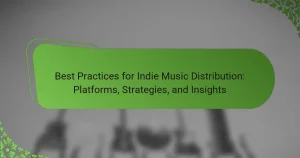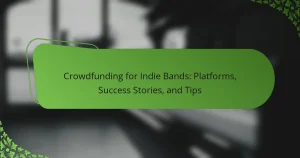Building a supportive indie music community fosters collaboration and inclusivity among artists and fans. Key strategies include hosting local shows, leveraging social media for promotion, and establishing mentorship programs. Success stories like “Bandcamp Friday” and the “DIY Venue Movement” highlight effective approaches to sustain and grow these communities. Emphasising diversity and networking opportunities further enriches the indie music scene.
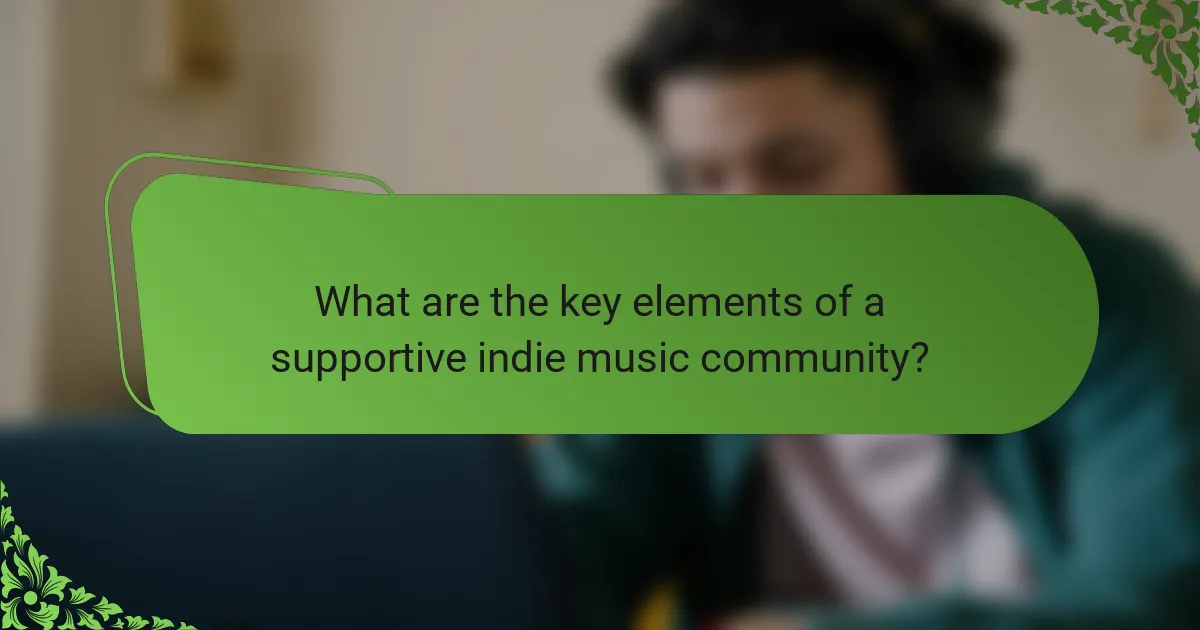
What are the key elements of a supportive indie music community?
A supportive indie music community thrives on collaboration, inclusivity, and shared resources. Key elements include local shows that foster connections, online platforms for promotion, and mentorship programs that nurture emerging talent. Engaging with fans through social media enhances visibility and creates a loyal following. Additionally, partnerships with local businesses can provide essential support, creating a sustainable ecosystem for artists.
How do collaboration and networking enhance community building?
Collaboration and networking significantly enhance community building by fostering connections and resource sharing. These interactions create a supportive environment where indie musicians can thrive.
Collaborative projects, such as joint performances or co-writing sessions, enable artists to share diverse skills and ideas. Networking events, like local music festivals or workshops, provide opportunities for musicians to meet industry professionals and fellow artists.
As a result, these strategies not only increase visibility but also build trust and camaraderie within the community. Success stories often highlight how collective efforts lead to stronger local scenes, showcasing the importance of unity in the indie music landscape.
What role do local venues play in fostering indie music scenes?
Local venues are crucial in nurturing indie music scenes by providing essential platforms for artists to perform and connect with audiences. They create spaces for collaboration and experimentation, fostering a sense of community among musicians and fans. Venues often host open mic nights and showcases, allowing emerging artists to gain exposure. Additionally, they contribute to the local economy by attracting visitors and promoting cultural events. This support helps sustain the indie music ecosystem, enabling artists to thrive and innovate.
How can online platforms support indie musicians and their communities?
Online platforms can significantly support indie musicians and their communities by fostering collaboration and providing resources. They can create spaces for musicians to connect, share their work, and receive feedback. Platforms like Bandcamp and SoundCloud offer tools for artists to distribute their music and engage with fans directly.
Additionally, social media channels enable musicians to build their brand and reach wider audiences. Crowdfunding platforms allow fans to financially support projects, enhancing community involvement. Success stories, such as the rise of artists like Chance the Rapper, highlight how these platforms can empower indie musicians to thrive independently.
Moreover, online workshops and webinars can educate artists on marketing, production, and distribution strategies. These initiatives strengthen the community by sharing knowledge and resources, ultimately leading to a more vibrant indie music scene.
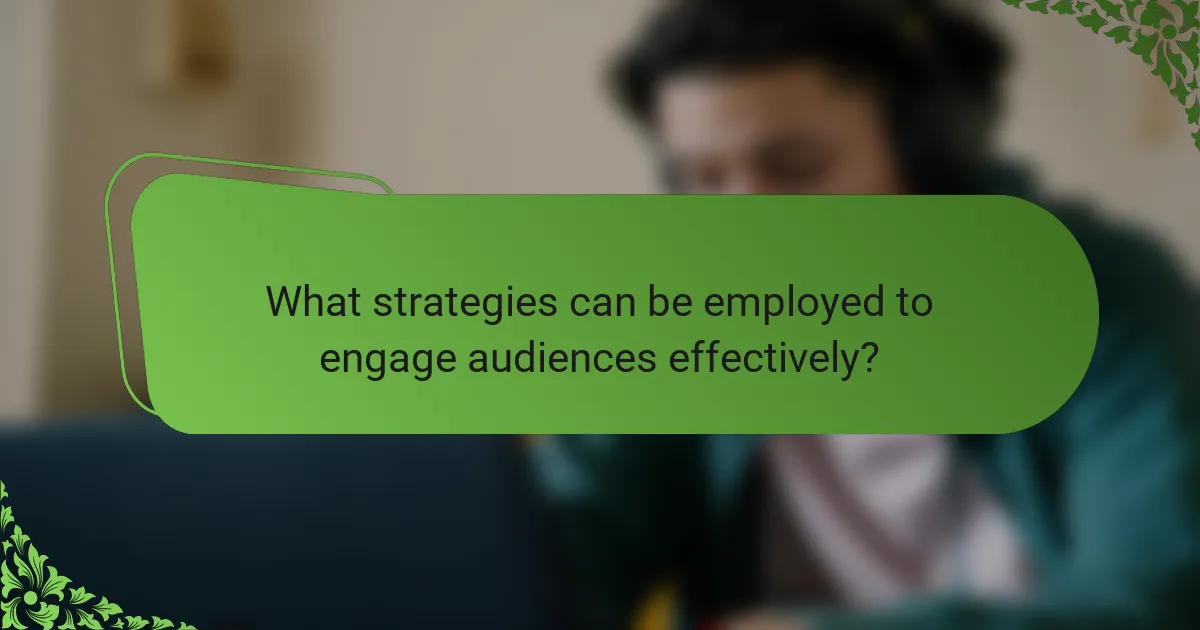
What strategies can be employed to engage audiences effectively?
Engaging audiences effectively in an indie music community requires targeted strategies. Building connections through social media platforms fosters interaction and showcases artists’ personalities. Hosting live events enhances community spirit and allows for direct engagement. Collaborating with local businesses can provide mutual support and expand reach. Sharing success stories inspires and motivates members, creating a sense of belonging.
How do social media campaigns impact community growth?
Social media campaigns significantly enhance community growth by fostering connections among indie music enthusiasts. They create platforms for sharing music, promoting events, and engaging directly with fans. Campaigns that utilise storytelling and user-generated content often see increased participation, leading to a stronger sense of belonging. For instance, artists who actively engage with their audience on platforms like Instagram and TikTok report higher interaction rates and community support. As a result, these campaigns not only promote individual artists but also cultivate a vibrant indie music ecosystem.
What are the benefits of hosting live events and showcases?
Hosting live events and showcases fosters community engagement, enhances visibility, and builds artist networks. These gatherings create opportunities for collaboration, allowing indie musicians to connect with fans and industry professionals. Additionally, live performances can generate revenue, increasing financial sustainability for artists. Such events also provide a platform for showcasing diverse talent, promoting inclusivity within the indie music scene.
How can crowdfunding initiatives support indie music projects?
Crowdfunding initiatives can significantly support indie music projects by providing financial resources and community engagement. These platforms enable artists to connect directly with fans, allowing them to fund albums, tours, and promotional activities.
Successful crowdfunding campaigns often leverage social media to build excitement and reach a wider audience. For instance, artists can share their stories, showcase their music, and offer exclusive rewards to backers. This approach fosters a sense of community and encourages fans to invest in the artists they love.
Moreover, crowdfunding helps indie musicians retain creative control over their work. Unlike traditional funding sources, artists can pursue their unique visions without compromising their artistic integrity. This empowerment can lead to innovative projects that resonate more deeply with audiences.
In summary, crowdfunding serves as a vital tool for indie music projects, facilitating financial backing, community support, and creative freedom.
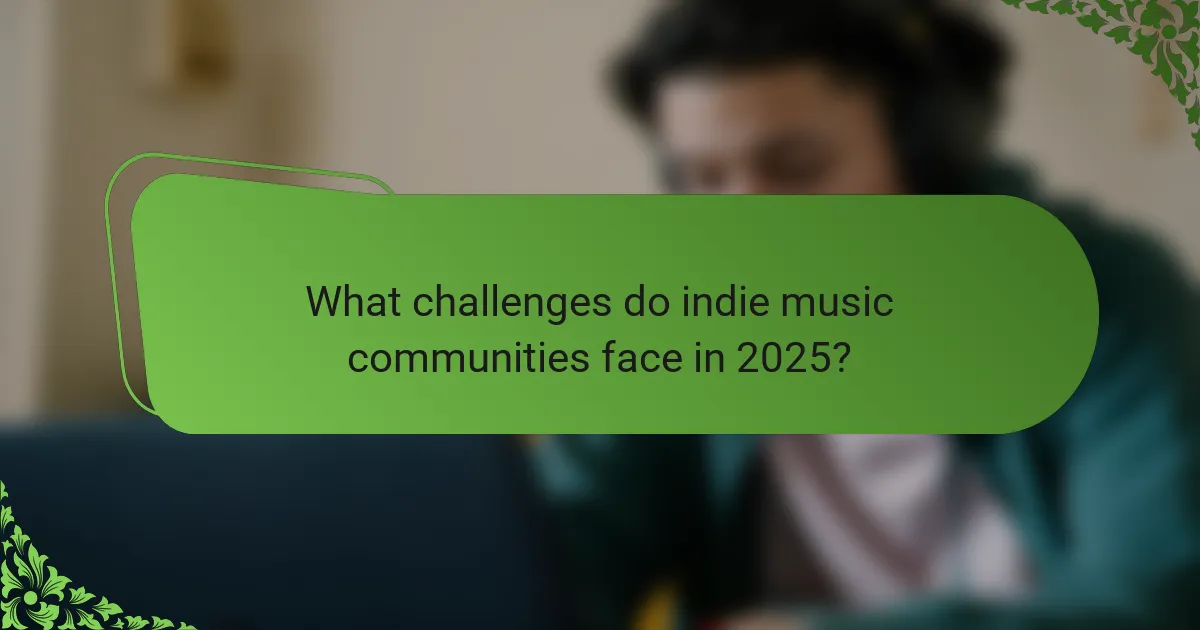
What challenges do indie music communities face in 2025?
Indie music communities in 2025 face challenges like funding shortages, digital competition, and limited venue access. These issues hinder collaboration and growth. To overcome these hurdles, communities can adopt strategies such as crowdfunding, leveraging social media for promotion, and hosting virtual events. Success stories highlight how local collectives have thrived by fostering inclusivity and prioritising artist support. By addressing these challenges with innovative solutions, indie music communities can build resilience and sustain their creative ecosystems.
How does competition with mainstream music affect indie artists?
Competition with mainstream music often challenges indie artists but also fosters community support. Indie artists can thrive by leveraging unique attributes like authenticity and niche appeal. Strategies include collaboration, local performances, and engaging with fans through social media. Success stories highlight indie labels that prioritise artist development over commercial pressure. By building a supportive community, indie artists can carve out distinct spaces within the music industry.
What are common financial hurdles for indie musicians?
Indie musicians face various financial hurdles, including limited income, high production costs, and inadequate funding sources. Many struggle with marketing expenses and distribution fees, which can impede growth. Additionally, inconsistent revenue from streaming platforms often complicates financial planning. Building a supportive community can help address these challenges through shared resources and collaborative opportunities.
How can community members combat burnout and maintain enthusiasm?
Community members can combat burnout and maintain enthusiasm by fostering open communication and collaboration. Building strong connections within the indie music community can create a supportive environment that reduces stress and promotes creativity. Regular check-ins and sharing experiences can help members feel valued and understood.
Encouraging group activities, such as jam sessions or workshops, can also boost morale and provide a sense of belonging. These collaborative efforts allow members to share their struggles and successes, reinforcing community ties.
Highlighting success stories within the community can inspire others and demonstrate the benefits of support. Celebrating achievements, no matter how small, can motivate members to stay engaged and passionate about their music journey.
Lastly, providing resources for mental health, such as workshops or access to professionals, can equip members with tools to manage stress effectively. Prioritising well-being fosters a resilient community that thrives on mutual support and enthusiasm.
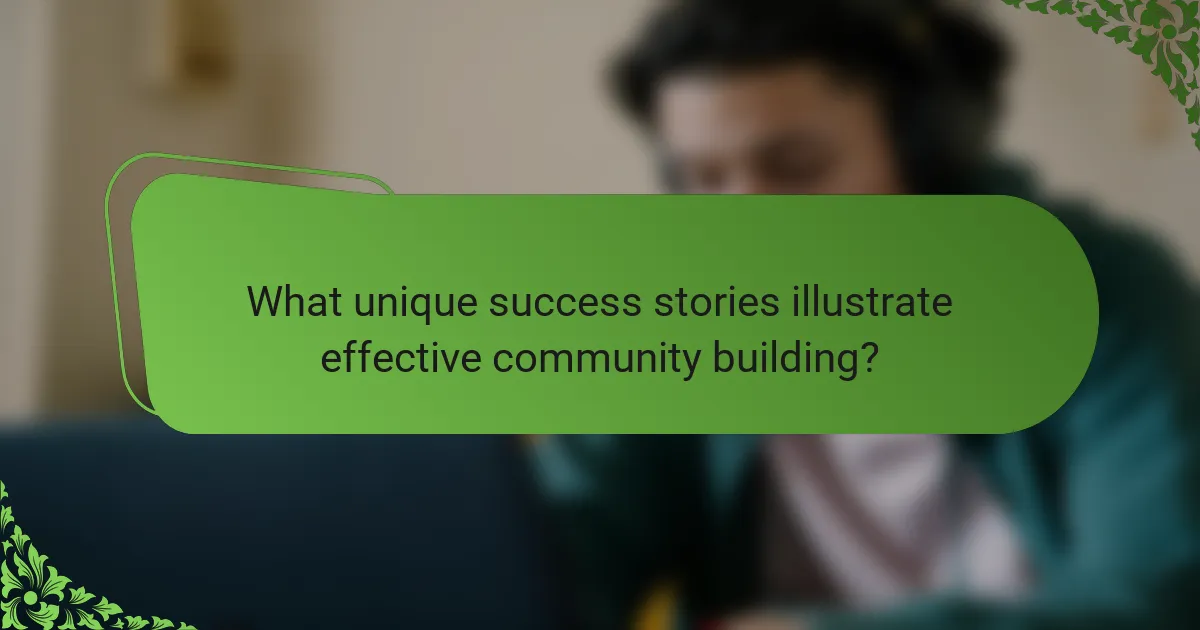
What unique success stories illustrate effective community building?
Building a supportive indie music community has led to numerous success stories. One notable example is the “Bandcamp Friday” initiative, where artists receive 100% of sales, fostering direct support from fans. This strategy significantly increased artist revenue and strengthened community ties. Another success story is the “DIY Venue Movement,” where local artists create their own spaces for performances, enhancing collaboration and audience engagement. These strategies illustrate how community-driven approaches can lead to sustainable success in the indie music scene.
Which indie collectives have made a significant impact in their regions?
Several indie collectives have made significant regional impacts by fostering local talent and creating vibrant music scenes. Notable examples include the DIY Music Collective in Los Angeles, known for its support of emerging artists, and the New England-based Collective Music, which emphasises collaboration and community engagement. The Brooklyn-based Indie Music Alliance has successfully hosted numerous festivals that showcase local musicians, enhancing their visibility. Each of these collectives demonstrates unique strategies that contribute to the growth and sustainability of their respective music communities.
How have grassroots movements transformed local music scenes?
Grassroots movements have significantly transformed local music scenes by fostering collaboration and community engagement. These movements create platforms for emerging artists, enhancing visibility and access to resources.
Strategies include organising local festivals, promoting DIY venues, and utilising social media for outreach. Success stories highlight how grassroots initiatives have revitalised neighbourhoods, attracting diverse audiences and encouraging cross-genre collaborations.
For example, community-led events often feature a mix of genres, bringing together artists and fans who might not typically interact. As a result, these movements cultivate a supportive environment that nurtures talent and builds lasting connections within the music community.
Ultimately, grassroots efforts empower local musicians, ensuring their voices resonate and thrive in a competitive industry.
What lessons can be learned from successful indie festivals?
Successful indie festivals foster community through collaboration, inclusivity, and support. These strategies create lasting connections among artists, fans, and organisers. For example, many festivals prioritise local talent, enhancing community engagement. Additionally, mentorship programs empower emerging artists, while diverse lineups attract wider audiences. Festivals that embrace sustainability practices also resonate with socially conscious attendees.
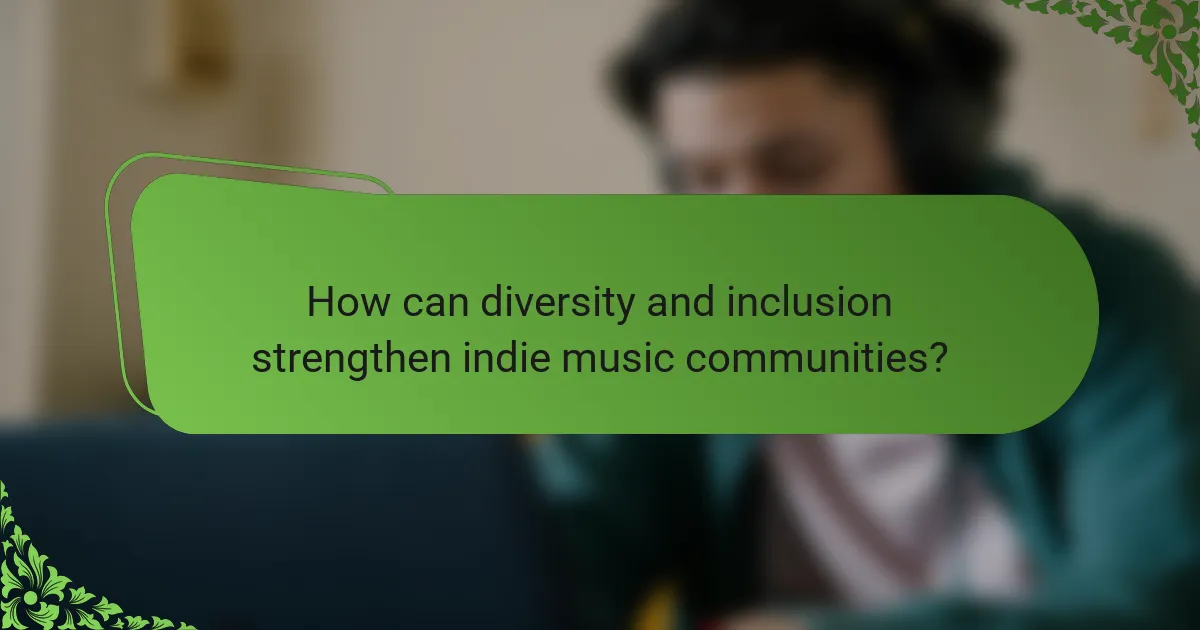
How can diversity and inclusion strengthen indie music communities?
Diversity and inclusion strengthen indie music communities by fostering creativity and collaboration. A diverse community brings varied perspectives, enriching the music produced and appealing to broader audiences. For instance, inclusive practices can enhance networking opportunities, leading to innovative partnerships and unique soundscapes. Additionally, representation in indie music encourages underrepresented artists, promoting a richer cultural tapestry. As a result, these communities thrive, creating supportive environments that nurture talent and amplify voices.
What initiatives promote underrepresented voices in indie music?
Initiatives that promote underrepresented voices in indie music include mentorship programs, community grants, and diverse music festivals. These efforts aim to amplify marginalised artists and foster inclusivity. For example, organisations like Women in Music provide resources and networking opportunities specifically for women in the industry. Additionally, initiatives like Bandcamp Fridays allow artists to retain more revenue, benefiting underrepresented groups. These strategies contribute to a richer, more diverse indie music landscape.
How does cultural representation enhance community engagement?
Cultural representation enhances community engagement by fostering inclusivity and a sense of belonging. It allows diverse voices to be heard, creating a richer musical landscape. This representation encourages participation, leading to increased collaboration among artists and audiences. As a result, community events become more vibrant and reflective of local identities, strengthening bonds and support within the indie music scene.
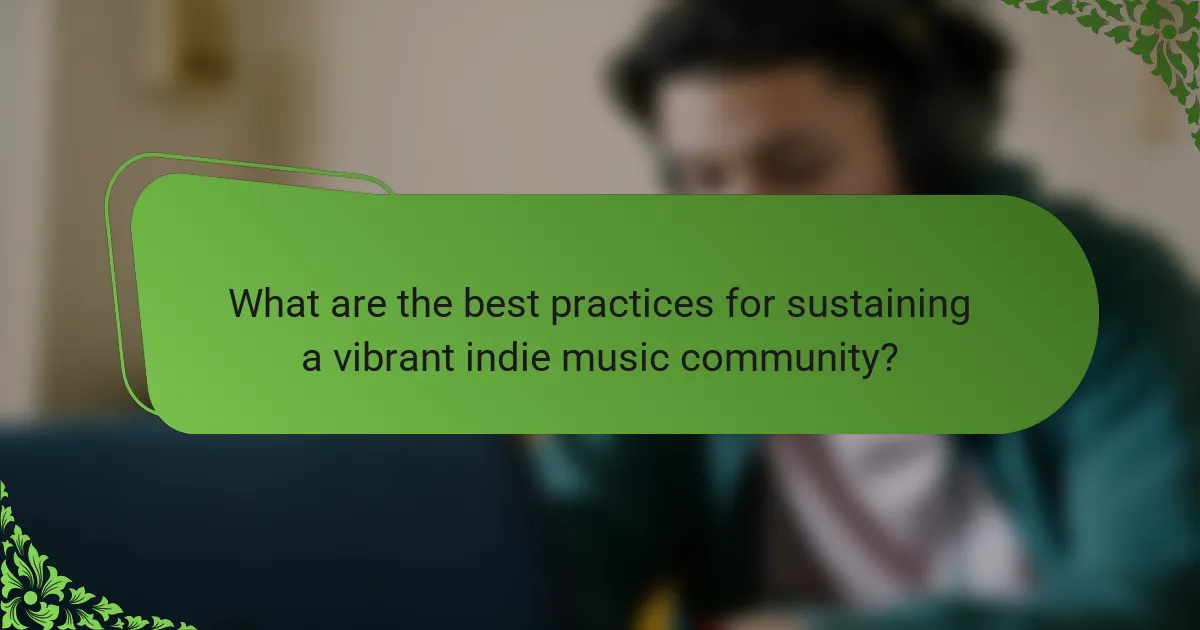
What are the best practices for sustaining a vibrant indie music community?
Building a vibrant indie music community requires fostering collaboration, promoting local talent, and creating inclusive spaces for interaction. Encourage local venues to host regular showcases, allowing artists to gain exposure. Establish mentorship programs connecting experienced musicians with newcomers, enhancing skill development. Utilise social media platforms to share success stories and build a sense of community. Organise workshops and events that focus on various aspects of music creation and promotion. Encourage networking among artists, producers, and fans to strengthen connections. Celebrate diversity within the community by highlighting underrepresented genres and artists, ensuring everyone feels valued.
How can mentorship programs support emerging artists?
Mentorship programs significantly support emerging artists by providing guidance, networking opportunities, and skill development. These programs connect artists with experienced mentors who offer valuable insights into the music industry.
Mentorship fosters collaboration within the indie music community, allowing emerging artists to share experiences and learn from one another. For example, mentorship can lead to opportunities for performance showcases, access to recording studios, and introductions to industry professionals.
Statistics show that 70% of mentored artists report improved confidence and career progression. This support is crucial in navigating challenges, such as securing funding or building a fan base.
Overall, mentorship programs play a vital role in nurturing talent and creating a thriving indie music ecosystem.
What strategies ensure long-term community involvement?
Engaging community members through consistent communication and shared experiences ensures long-term involvement. Strategies include hosting regular events, fostering collaboration among artists, and utilising social media for updates and feedback. These approaches create a sense of belonging and encourage active participation. Success stories highlight how local indie music scenes thrive through grassroots efforts and community-driven initiatives, reinforcing the value of sustained engagement.
How can feedback loops improve community dynamics?
Feedback loops enhance community dynamics by fostering communication and collaboration. They enable members to share experiences, provide input, and adapt strategies based on collective feedback. This process strengthens relationships and builds trust within the indie music community. As a result, artists and fans become more engaged, leading to a vibrant and supportive environment. Regular feedback can also highlight unique talents and rare opportunities, helping to elevate the community as a whole.
What common mistakes should indie music communities avoid?
Indie music communities should avoid common mistakes that hinder growth and collaboration. Prioritising inclusivity fosters a welcoming environment. Neglecting communication can lead to misunderstandings and disengagement. Focusing solely on commercial success undermines artistic integrity. Lastly, overlooking local talent can stifle community development.
